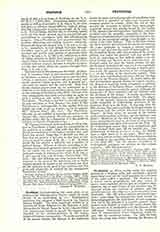

Province, ECCLESIASTICAL, the name given to an ecclesiastical administrative district under the jurisdiction of an Archbishop (q.v.). Ecclesiastical provinces first assumed a fixed form in the Eastern Roman Empire. The more important centers (e.g. Antioch for Syria, Ephesus for the Province of Asia, Alexandria for Egypt, Rome for Italy), whence Christian missionaries issued to preach the Gospel, were regarded as the mother-churches of the newly-founded Christian communities. From the second half of the second century the bishops of the territories within the same natural geographical boundaries were accustomed to assemble on important occasions for common counsel in synods. From the end of that century the summons to attend these increasingly important synods was usually issued by the bishop of the capital of the state province (eparchy), who also presided over the assembly, especially in the East. Important communications were also forwarded to the bishop of the provincial capital to be brought to the notice of the other bishops. Thus in the East during the third century the bishop of the provincial metropolis came gradually to occupy a certain superior position, and received the name of metropolitan. At the Council of Nicaea (325) this position of the metropolitan was taken for granted, and was made the basis for conceding to him definite rights over the other bishops and dioceses of the state province. In Eastern canon law since the fourth century (cf. also the Synod of Antioch of 341, can. ix), it was a principle that every civil province was likewise a church province under the supreme direction of the metropolitan, i.e. of the bishop of the provincial capital. This division into ecclesiastical provinces did not develop so early in the Western Empire. In North Africa the first metropolitan appears during the fourth century, the Bishop of Carthage being recognized as primate of the dioceses of Northern Africa; metropolitans of the separate provinces gradually appear, although the boundaries of these provinces did not coincide with the divisions of the empire. A similar development was witnessed in Spain, Gaul, and Italy. The migration of the nations, however, prevented an equally stable formation of ecclesiastical provinces in the Christian West as in the East. It was only after the fifth century that such gradually developed mostly in accordance with the ancient divisions of the Roman Empire. In Italy alone, on account of the central ecclesiastical position of Rome, this development was slower. However, at the end of antiquity the existence of church provinces as the basis of ecclesiastical administration was fairly universal in the West. In the Carlovingian period they were reorganized, and have retained their place till the present day. The delimitation of church provinces is since the Middle Ages a right reserved to the pope. There have always been, and are today, individual dioceses which do not belong to any province, but are directly subject to the Holy See. For the present boundaries of ecclesiastical provinces see articles on the various countries. (See Metropolitan.)
J. P. KIRSCH

